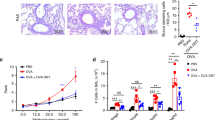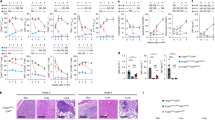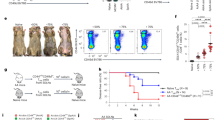Abstract
Regulatory T cells are promising candidates for the modulation of inflammation and autoimmunity. To generate regulatory T cells in vitro, we have infected naïve CD4+CD25− T cells with a retrovirus encoding the transcription factor Foxp3. Foxp3-infected T cells are similar to naturally occurring regulatory T cells as evidenced by surface marker expression and function. To investigate the effects of Foxp3-infected T cells on contact hypersensitivity (CHS) responses, sensitized mice were injected with Foxp3- or control virus-infected T cells. Only injection of Foxp3-infected T cells into sensitized mice significantly inhibited CHS compared to controls, indicating that Foxp3-infected T cells are suppressive in vivo. These findings prompted treatment of autoimmune-prone CD40L transgenic (tg) mice, which develop a severe systemic autoimmune disease including autoreactive T cells and autoantibodies, with Foxp3-infected T cells. Interestingly, injections of Foxp3-infected T cells into CD40L tg mice inhibited the ongoing development of autoimmune dermatitis and activation of cytotoxic CD8+ T cells. Strikingly, treatment with Foxp3-infected T cells reduced serum concentrations of antinuclear antibodies in CD40L tg mice, which was paralleled with reduced renal immunoglobulin depositions and increased kidney function. Together, these findings indicate that newly in vitro-generated regulatory T cells can be successfully used to treat inflammatory and ongoing autoimmune disorders.
This is a preview of subscription content, access via your institution
Access options
Subscribe to this journal
Receive 12 print issues and online access
$259.00 per year
only $21.58 per issue
Buy this article
- Purchase on Springer Link
- Instant access to full article PDF
Prices may be subject to local taxes which are calculated during checkout







Similar content being viewed by others
References
Sakaguchi S et al. Immunologic tolerance maintained by CD25+ CD4+ regulatory T cells: their common role in controlling autoimmunity, tumor immunity, and transplantation tolerance. Immunol Rev 2001; 182: 18–32.
Shevach EM, McHugh RS, Piccirillo CA, Thornton AM . Control of T-cell activation by CD4+ CD25+ suppressor T cells. Immunol Rev 2001; 182: 58–67.
Sakaguchi S et al. Immunologic self-tolerance maintained by activated T cells expressing IL-2 receptor alpha-chains (CD25). Breakdown of a single mechanism of self-tolerance causes various autoimmune diseases. J Immunol 1995; 155: 1151–1164.
Suri-Payer E, Amar AZ, Thornton AM, Shevach EM . CD4+CD25+ T cells inhibit both the induction and effector function of autoreactive T cells and represent a unique lineage of immunoregulatory cells. J Immunol 1998; 160: 1212–1218.
Piccirillo CA, Shevach EM . Cutting edge: control of CD8+ T cell activation by CD4+CD25+ immunoregulatory cells. J Immunol 2001; 167: 1137–1140.
Powrie F et al. A critical role for transforming growth factor-beta but not interleukin 4 in the suppression of T helper type 1-mediated colitis by CD45RB(low) CD4+ T cells. J Exp Med 1996; 183: 2669–2674.
Asseman C et al. An essential role for interleukin 10 in the function of regulatory T cells that inhibit intestinal inflammation. J Exp Med 1999; 190: 995–1004.
Bruder D et al. Neuropilin-1: a surface marker of regulatory T cells. Eur J Immunol 2004; 34: 623–630.
Iellem A et al. Unique chemotactic response profile and specific expression of chemokine receptors CCR4 and CCR8 by CD4(+)CD25(+) regulatory T cells. J Exp Med 2001; 194: 847–853.
Lehmann J et al. Expression of the integrin alpha Ebeta 7 identifies unique subsets of CD25+ as well as CD25− regulatory T cells. Proc Natl Acad Sci USA 2002; 99: 13031–13036.
McHugh RS et al. CD4(+)CD25(+) immunoregulatory T cells: gene expression analysis reveals a functional role for the glucocorticoid-induced TNF receptor. Immunity 2002; 16: 311–323.
Read S, Malmstrom V, Powrie F . Cytotoxic T lymphocyte-associated antigen 4 plays an essential role in the function of CD25(+)CD4(+) regulatory cells that control intestinal inflammation. J Exp Med 2000; 192: 295–302.
Read S et al. CD38+ CD45RB(low) CD4+ T cells: a population of T cells with immune regulatory activities in vitro. Eur J Immunol 1998; 28: 3435–3447.
Thornton AM, Donovan EE, Piccirillo CA, Shevach EM . Cutting edge: IL-2 is critically required for the in vitro activation of CD4+CD25+ T cell suppressor function. J Immunol 2004; 172: 6519–6523.
Malek TR et al. CD4 regulatory T cells prevent lethal autoimmunity in IL-2Rbeta-deficient mice. Implications for the nonredundant function of IL-2. Immunity 2002; 17: 167–178.
Kumanogoh A et al. Increased T cell autoreactivity in the absence of CD40–CD40 ligand interactions: a role of CD40 in regulatory T cell development. J Immunol 2001; 166: 353–360.
Salomon B et al. B7/CD28 costimulation is essential for the homeostasis of the CD4+CD25+ immunoregulatory T cells that control autoimmune diabetes. Immunity 2000; 12: 431–440.
Lohr J et al. The inhibitory function of B7 costimulators in T cell responses to foreign and self-antigens. Nat Immunol 2003; 4: 664–669.
Akbari O et al. Antigen-specific regulatory T cells develop via the ICOS–ICOS-ligand pathway and inhibit allergen-induced airway hyperreactivity. Nat Med 2002; 8: 1024–1032.
Fontenot JD, Gavin MA, Rudensky AY . Foxp3 programs the development and function of CD4+CD25+ regulatory T cells. Nat Immunol 2003; 4: 330–336.
Hori S, Nomura T, Sakaguchi S . Control of regulatory T cell development by the transcription factor Foxp3. Science 2003; 299: 1057–1061.
Khattri R, Cox T, Yasayko SA, Ramsdell F . An essential role for Scurfin in CD4+CD25+ T regulatory cells. Nat Immunol 2003; 4: 337–342.
Viglietta V, Baecher-Allan C, Weiner HL, Hafler DA . Loss of functional suppression by CD4+CD25+ regulatory T cells in patients with multiple sclerosis. J Exp Med 2004; 199: 971–979.
Herold KC et al. Anti-CD3 monoclonal antibody in new-onset type 1 diabetes mellitus. N Engl J Med 2002; 346: 1692–1698.
Sakaguchi S . The origin of FOXP3-expressing CD4+ regulatory T cells: thymus or periphery. J Clin Invest 2003; 112: 1310–1312.
Shevach EM . CD4+ CD25+ suppressor T cells: more questions than answers. Nat Rev Immunol 2002; 2: 389–400.
Akiba H et al. Skin inflammation during contact hypersensitivity is mediated by early recruitment of CD8+ T cytotoxic 1 cells inducing keratinocyte apoptosis. J Immunol 2002; 168: 3079–3087.
Mehling A et al. Overexpression of CD40 ligand in murine epidermis results in chronic skin inflammation and systemic autoimmunity. J Exp Med 2001; 194: 615–628.
Chatenoud L, Salomon B, Bluestone JA . Suppressor T cells – they're back and critical for regulation of autoimmunity!. Immunol Rev 2001; 182: 149–163.
Schwarz A et al. Ultraviolet radiation-induced regulatory T cells not only inhibit the induction but can suppress the effector phase of contact hypersensitivity. J Immunol 2004; 172: 1036–1043.
Thornton AM, Shevach EM . CD4+CD25+ immunoregulatory T cells suppress polyclonal T cell activation in vitro by inhibiting interleukin 2 production. J Exp Med 1998; 188: 287–296.
Thornton AM, Shevach EM . Suppressor effector function of CD4+CD25+ immunoregulatory T cells is antigen nonspecific. J Immunol 2000; 164: 183–190.
Finotto S, Glimcher L . T cell directives for transcriptional regulation in asthma. Springer Semin Immunopathol 2004; 25: 281–294.
Wildin RS et al. X-linked neonatal diabetes mellitus, enteropathy and endocrinopathy syndrome is the human equivalent of mouse scurfy. Nat Genet 2001; 27: 18–20.
Brunkow ME et al. Disruption of a new forkhead/winged-helix protein, scurfin, results in the fatal lymphoproliferative disorder of the scurfy mouse. Nat Genet 2001; 27: 68–73.
Bennett CL et al. The immune dysregulation, polyendocrinopathy, enteropathy, X-linked syndrome (IPEX) is caused by mutations of FOXP3. Nat Genet 2001; 27: 20–21.
Anastasi E et al. Expression of activated Notch3 in transgenic mice enhances generation of T regulatory cells and protects against experimental autoimmune diabetes. J Immunol 2003; 171: 4504–4511.
Bellavia D et al. Constitutive activation of NF-kappaB and T-cell leukemia/lymphoma in Notch3 transgenic mice. EMBO J 2000; 19: 3337–3348.
Jonuleit H et al. Induction of interleukin 10-producing, nonproliferating CD4(+) T cells with regulatory properties by repetitive stimulation with allogeneic immature human dendritic cells. J Exp Med 2000; 192: 1213–1222.
Steinbrink K et al. CD4(+) and CD8(+) anergic T cells induced by interleukin-10-treated human dendritic cells display antigen-specific suppressor activity. Blood 2002; 99: 2468–2476.
Yamazaki S et al. Direct expansion of functional CD25+ CD4+ regulatory T cells by antigen-processing dendritic cells. J Exp Med 2003; 198: 235–247.
Mahnke K, Qian Y, Knop J, Enk AH . Induction of CD4+/CD25+ regulatory T cells by targeting of antigens to immature dendritic cells. Blood 2003; 101: 4862–4869.
Gunzer M, Weishaupt C, Planelles L, Grabbe S . Two-step negative enrichment of CD4+ and CD8+ T cells from murine spleen via nylon wool adherence and an optimized antibody cocktail. J Immunol Methods 2001; 258: 55–63.
Scholzen TE et al. Modulation of cutaneous inflammation by angiotensin-converting enzyme. J Immunol 2003; 170: 3866–3873.
Acknowledgements
We thank Maik Voskort and Joachim Windau for excellent technical assistance. This work was funded by the German Research Association (DFG), Grant SFB293 B8 (to SB).
Author information
Authors and Affiliations
Rights and permissions
About this article
Cite this article
Loser, K., Hansen, W., Apelt, J. et al. In vitro-generated regulatory T cells induced by Foxp3-retrovirus infection control murine contact allergy and systemic autoimmunity. Gene Ther 12, 1294–1304 (2005). https://doi.org/10.1038/sj.gt.3302567
Received:
Accepted:
Published:
Issue Date:
DOI: https://doi.org/10.1038/sj.gt.3302567
Keywords
This article is cited by
-
Lipopolysaccharide Accelerates Neuropilin-1 Protein Degradation by Activating the Large GTPase Dynamin-1 in Macrophages
Inflammation (2022)
-
Development of gene transfer for induction of antigen-specific tolerance
Molecular Therapy - Methods & Clinical Development (2014)
-
Hydroxychloroquine decreases the upregulated frequencies of Tregs in patients with oral lichen planus
Clinical Oral Investigations (2014)
-
Epigenetic Modification of the FoxP3 TSDR in HAM/TSP Decreases the Functional Suppression of Tregs
Journal of Neuroimmune Pharmacology (2014)
-
Regulatory T Cells: Banned Cells for Decades
Journal of Investigative Dermatology (2012)



